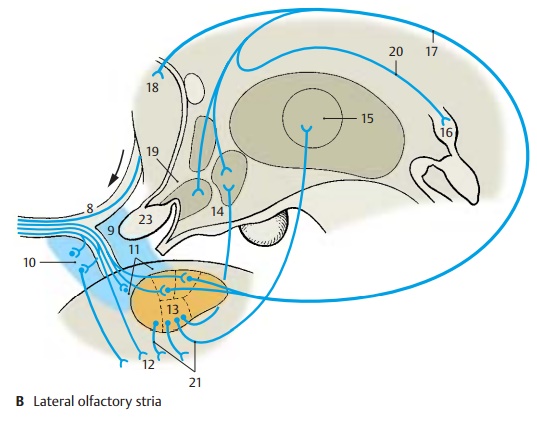Chapter: Human Nervous System and Sensory Organs : Telencephalon
Fiber Connections - Paleocortex and Amygdaloid Body

Fiber Connections
Olfactory Bulb (A)
The bundled axons of the olfactory cells (A1) pass as olfactory nerves (1st neuron) through the openings of the cri-briform lamina (A2) into the olfactory bulb (A3). Here they terminate on the dendrites of the mitral cells (A4) with which they form glomeruli (A5). In this glomerular system,one mitral cell is in contact with numerous sensory cells. Other cell types, such as granule cells, periglomerular cells, and tufted cells, belong to the integration center of theolfactory bulb. The axons of the mitral cells (2nd neuron) pass through the olfactory tract (A6) to the primary olfactory centers. Me-dium-sized neurons are scattered along the olfactory tract; they constitute the anteriorolfactory nucleus (AC7). The axons, or theircollaterals, of the mitral cells terminate here. The neuronal processes partly cross through the anterior commissure to the contralateral olfactory bulb, where they form the medial olfactory stria (B8).

Lateral Olfactory Stria (B)
All fibers of the mitral cells extend in the lateral olfactory stria to the primary ol-factory centers, namely, the anterior per-forated substance (olfactory area) (BC9), the prepiriform area (B10), and the periamyg-dalar area (B11) including the cortical nu-cleus of the amygdaloid body. The prepir-iform area and the periamygdalar area are thought to be the olfactory cortex proper for the conscious perception of olfactory stimuli. The medial olfactory stria is thought to receive exclusively fibers run-ning from the olfactory cortex to the ol-factory bulb.
Fiber systems extend from the olfactory cor-tex (olfactory impulses for the search for food, food uptake, and sexual behavior) to the entorhinal area (B12), to the basolateral nuclear group of the amygdaloid body (BC13), to the anterior and lateral portions of the hypothalamus (B14), and to the mag-nocellular nucleus of the medial thalamic nuclei (B15). A connection to the centers ofthe brain stem is established through fibers running to the habenular nuclei (B16). These association pathways do not directly belong to the olfactory system.

Amygdaloid Body (B)
The basolateral nuclear group receives fibers from the premotor, prefrontal, and temporal cortices; from the magnocellular nucleus of the medial thalamic nuclei; and from nonspecific thalamic nuclei. The most important efferent fiber system of the amygdaloid body is thestria terminalis(BC17). It arches in the sulcus between cau-date nucleus and thalamus and runs below the thalamostriate vein as far as the anterior commissure. Its fibers terminate in the septal nuclei (B18), in the preoptic area (B19), and in the nuclei of the hypothalamus. Fiber bundles cross from the stria terminalis into the medullary stria (B20) and extend to the habenular nuclei. Other efferent bundles from the basolateral portion of the amygdaloid body extend as ventral amygdalofugal fibers (B21) to the en-torhinal area, to the hypothalamus, and tothe medial thalamic nuclei, from where ad-ditional connections lead to the frontal lobe. The stria terminalis is rich in peptidergic fibers.
Anterior Commissure (C)
In the anterior part of the anterior commis-sure, fibers of the olfactory tract (anterior olfactory nucleus) (AC7) and fibers of the ol-factory cortex (BC9) cross to the con-tralateral side. The anterior part is poorly developed in humans. The main part is formed by the posterior part, where fibers of the temporal cortex (C22) cross; they are primarily from the cortex of the medial temporal gyrus. Furthermore, the posterior part contains crossing fibers from the amyg-daloid bodies (BC13) and the striae (termi-nales) (BC17).
B23 Optic chiasm.

Related Topics